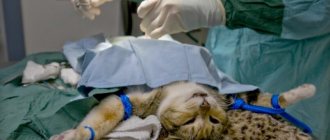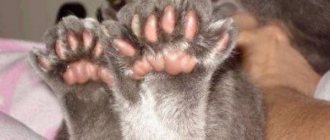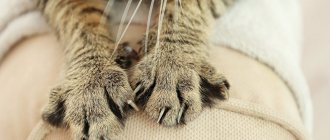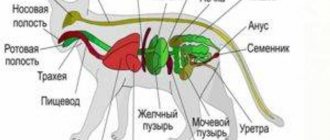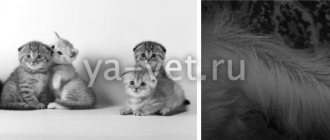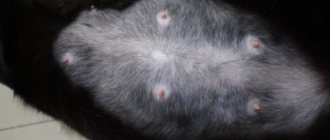The meaning of the tail in the life of cats
To understand the dangers of pulling a cat's tail, it is important to understand the basic functions of this part of the body. It is necessary for a full-fledged cat’s existence and performs the following tasks:
- serves as a balance regulator when jumping and moving in height;
- if you fall, it helps you “steer out” and fall straight on your paws, avoiding injury;
- is a means of communication: through movements of the tail, the cat communicates with its relatives and expresses its emotions towards its owners.
There are breeds whose standard implies a short tail or almost no tail. For example, tailless Manxes have 2–3 tail vertebrae (while most breeds have 20–27).
These cats have more developed hind limbs, which partly compensate for their natural taillessness. If an animal loses its tail in adulthood, its motor and communication functions will be impaired.
The tail contains nerve endings
Anyone who has ever had a furry pet knows that cats don't like it when someone else touches their tail. Not only do they not like it when it is pulled or grabbed, but they also cannot tolerate any, even the slightest, touch to this part of the body. The fact is that cats have nerve endings in their tails that react to the external environment. Even a minor injury to this part of the body causes very severe pain for the pet, so you should not pull it in this place. If you want to pet a cat, then avoid this part; the animal itself will pull it back even if you accidentally touch it.
Spine part
Cat owners know how carefully their pets treat their own tail, protecting it from careless touches of guests and household members. And this is no coincidence, because the tail contains many nerve endings necessary for the normal functioning of the animal.
Even the slightest injury in this area causes unbearable pain to the pet. For this reason alone, for caring owners, the answer to the question of whether it is possible to pull a cat’s tail is obvious.
In addition, it should be borne in mind that the tail is an extension of the spine. It consists of individual vertebrae that are connected to each other by cartilage and joints that provide mobility.
The first 5–8 caudal vertebrae are absolutely identical in structure to the elements of the main parts of the spine (that is, they have a body and an arch); in the remaining parts there is no spinal canal.
It is necessary to pay attention to the fact that cats are not docked for aesthetic purposes, like dogs. Any damage to this area compromises the functioning of the animal's nervous system. The health consequences can be quite serious, including complete loss of sensation in the back of the body.
The tail is an extension of the animal's spine
Another reason why you shouldn't grab a cat's tail is that it is an extension of your pet's spine. It contains vertebrae, joints and cartilage, due to which this part of the body is quite flexible. If the tail is damaged, the cat will not be able to walk normally, since its integrity is directly related to its musculoskeletal system. This is why they are not stopped in cats.
There is also a saying that if you pull a cat by the tail, he will stop going to the litter box and start doing his business in any other place. This is not fiction, it is true. The fact is that if it is damaged, the functioning of the pet’s genitourinary system may be disrupted, which may result in urinary incontinence, bladder disease, or even paralysis of the hind legs.
If you pull a cat's tail, it may "shit"
In search of an answer to the question of what will happen if a cat is pulled by the tail, many have probably come across the popular belief that the animal will then begin to “shit anywhere.” You shouldn’t brush this off as ridiculous superstitions about empty buckets and haircuts during pregnancy.
In this case, the conclusion of “collective intelligence” has good grounds. As mentioned above, the tail is part of the spine, and damage to the spinal column can cause complete or partial paralysis of the lower extremities, fecal and urinary incontinence.
If your cat was regularly subjected to unceremonious treatment by members of the household, and then suddenly began to relieve himself outside of specially designated places, you should not be angry with him, much less punish him. Perhaps these are the consequences of a spinal injury resulting from a sharp tug on the tail.
Why do cats have tails?
The tail is a very important part of the body for domestic felines. It really helps cats navigate space and establish coordination. Thanks to these features, cats can:
- climb trees freely;
- jump and stay on top;
- when falling from a height, successfully land on your feet;
- get through narrow openings;
- walk on narrow surface areas;
- catch small rodents and insects.
Of course, there are tailless and short-tailed cat breeds, representatives of which perfectly balance and land on the surface without the help of a tail. Most likely, they are satisfied with his small likeness, which is also significant. But still, long-tailed cats are more agile and nimble compared to their relatives.
The tail helps cats express their emotions and feelings. Surely, you have noticed more than once how your pet, when greeting you, shows joy by raising its tail high in a “pipe”. If the cat sits with her tail wrapped around her paws, this is also a good sign, hinting at a friendly disposition towards you. But when preparing for some reckless act, the animal usually waves its tail in different directions. A very frightened or aggressive cat is usually identified by a tail with tousled hair.
Thanks to this fluffy appendage, heat-loving cats keep warm by curling up in a ball and as if covering themselves with it.
When should you contact a veterinarian?
Serious damage to the tail is usually visible to the naked eye. You should seek veterinary help if your pet has the following symptoms:
- visible break or break in the tail area;
- painful reaction to touch;
- the tail is hot and inflamed, there is severe swelling;
- problems with the hind limbs, loss of balance, gait disturbance;
- the animal is unable to support its tail, it hangs like a whip;
- loss of previously formed neatness skills: involuntary defecation or urination.
How does a cat's spine work?
These animals have a special vertebral structure. And this can be understood by looking at how the pet curls up into a ball. There are 7 cervical vertebrae. They are connected elastically, which allows the cat to turn its head almost 180 degrees. Almost none of the vertebrates can do this.
The thoracic region consists of 13 vertebrae. 7 vertebrae are responsible for the lumbar region. This section is very flexible, so the cat can easily curl up into a ball, turn over when flying in the air, and gracefully arch its back at incredible angles.
The sacral section consists of 3 large vertebrae. They are strong and immovable. Thanks to their rigid fastening, the purr jumps well.
As we can see, a cat's spine consists of 30 vertebrae. And that's not counting the tail section.
Injury Prevention
As you know, any disease is easier to prevent than to treat. Therefore, in conclusion, let’s talk about preventive measures.
- Be careful when handling the animal. If you need to catch him, don't grab his tail - it's dangerous!
- Limit your pet's access to the street. If you have a private home, equip heavy doors with a soft-closing mechanism.
- Explain clearly to children and other family members why it is wrong to pull a cat's tail, using arguments appropriate to their level of understanding.
- If the baby is very small, do not leave the cat alone with him: this can be dangerous not only for the pet, but also for the child himself.
And remember, we are responsible for those we have tamed. Develop in children love and compassion for all living things from an early age - this will make them more responsible and happy!
Functions of the tail
We find out why you should not pull a cat's tail and why it is dangerous. Before we look at this issue, let's learn about the functions of a cat's tail.
This is not just an unnecessary attribute in the animal’s exterior. One of the main functions of this part of the cat's body is to help coordinate movement and orientation in space.
Someone will be surprised: what about tailless breeds, such as the Kuril Bobtail? Cats that lack a tail due to the breed standard have much poorer spatial orientation. They are less dexterous and agile than their tailed relatives.
The second function of the tail is the transmission of emotions. With its help, the cat expresses its attitude to the world.
So, if a pet begins to nervously twitch its tail, this indicates its dissatisfaction. The state of excitement of the nervous system is also indicated by striking the floor with the tail.
A calm cat, rejoicing at its owner, runs towards him, holding its tail in a vertical position. They also say about him “the tail of the pipe.”
Before an attack, the animal begins to beat its tail, jerking it from side to side.
When frightened, the cat arches and bends its tail. In this case, this part of the body becomes fluffy and resembles a “brush”.
How does a tail reveal your mood?
The sign language of animals is unusually developed. And if it’s not always possible to determine a pet’s mood by its face, then its tail gives it away. He will convey everything that the cat likes or dislikes with his condition.
- You can tell if a cat is in a playful mood if the tail twitches when held upright. When he begins to make sharp blows to the floor, this is a signal that it is time to stop the game.
- The irritated state of a pet can be determined by its tail jerking sharply from side to side. In some cases, a raised tail with a curved tip indicates that the cat is nervous.
- Feelings of pain and stress also often cause a cat to twitch its tail. She makes smaller movements with it, sometimes knocking on the floor.
- If the fur on the back rises along with the twitching of the tail, this means that the animal is in an extreme state of excitement and is capable of attacking.
Knowing the possible reasons why a cat may twitch its tail, it is easy to determine its mood and needs. This behavior is not necessarily a signal of negative feelings. The ability to read the sign language that animals speak helps establish mutual understanding between the owner and the pet.
Reason to contact the veterinarian
Tail injuries are one of the most common reasons for which people bring their cats to veterinary clinics. The cause of injury may be careless handling of the animal, an attempt to sharply grab its tail, or the owner could unintentionally step on this part of the body.
What are the signs of injury?
- The cat is lethargic, trying to hide in a secluded place, its tail hanging like a whip.
- The pet is unable to control its tail. The eyes are cloudy, the pet itself is inactive, refuses food and water.
- Visible tumors at the base of the tail. All kinds of bumps and growths.
- A break in the tail, a visible break in it.
- The tail is swollen, the swelling is visible to the naked eye. When touched, the tail is hot to the touch and very hard.
- If the owner notices that his cat has pronounced gait disturbances, the hind limbs do not obey the animal, then this is a serious reason to immediately contact “Doctor Aibolit.”
- A previously clean pet is unable to control urination and fecal waste.
If these deviations are detected, a visit to the veterinarian should not be delayed. The faster the cat receives help, the less dangerous the consequences of the injury will be.
The tail is an indicator of the cat's emotions
Most often, a cat twitches its tail to communicate its mood. Depending on how and how actively she begins to move it, the owner can guess what emotions his pet is experiencing:
- Excess of feelings. Often a cat's tail twitches when a person pets the animal. Combined with purring, this means that the cat is absolutely happy. He is satisfied with the owner's attention and hurries to tell him about it.
- Interest in something. The cat's tail stands upright when the pet is happy and expects something pleasant (for example, it is time to feed). But when he begins to smoothly move it up and down, this is a sign that the cat is interested in some thing or object. He will walk around it, sniff it, try to catch it. It could be anything: a fly flying by, a new toy, a bag of groceries.
- Irritation. Experiencing such emotions, the cat begins to rhythmically jerk its tail left and right. This is how she shows that the current situation is unpleasant for her. For example, a pet may feel that the timing for affection is poorly chosen.
- Fear, panic. It is not difficult for a person to determine that a cat is very scared - the animal twitches its tail, hitting it on the floor with all its force. His whole body is shaking, his pupils are dilated, and the cat itself can make plaintive sounds. At such moments, the pet should not be touched. The best thing the owner can do is to eliminate the situation or object that frightened the animal.
